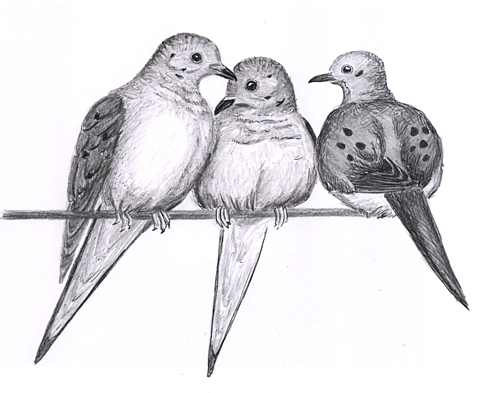
Dear Bird Folks:
Last night, while jogging on the bike trail in Eastham, I came upon a huge flock of Mourning Doves. There must have been fifty to a hundred doves sitting together on the overhead power lines. I jog this trail every day and have never seen such a mass of doves. It was like something out of the movie “The Birds”. What is going on?
-David, Eastham
Calm Down Dave,
It will be okay.
Mourning Doves aren’t taking over Eastham. But your thought about the flock of doves reminding you of the film “The Birds” is interesting. In the evening, doves often form flocks that sit perched in eerie silence. It was a flock such as the one that you saw in Eastham that gave Alfred Hitchcock his idea for his famous movie. Like you, Alfred Hitchcock was quite the runner. He was often seen zipping around the Hollywood hills in his Spandex jogging suit. Apparently, right at the end of one of his 10K runs, he too came upon a flock of doves that gave him the inspiration for the movie. Or so the story goes.
Flocking upon wires is not unusual for doves. The reason that you haven’t noticed it recently is because they have just finished their breeding cycle. For the past four or five months adult Mourning Doves have been hanging out in pairs, and not in large groups. By September, they have had enough of the family stuff and are getting to know their neighbors once again.
Many birds group together in obvious flocks at the end of the day. Birds of the same species come from all directions to gather before they all settle into their roosting site. Humans do the same thing, only we call it “happy hour”.
For doves, this end of the day ritual serves another purpose: digestion. As you know, doves eat mostly seeds. Unlike most of our other feeder birds that need to crack open the seeds before eating, doves eat everything whole. Their gizzard does the work of grinding up the shells. It is during these late afternoon gatherings that doves sit quietly digesting the day’s seed intake.
The other possibility for suddenly finding a large flock of doves is migration. Since we see doves year round, we don’t think of them as migrants, but they are. Thousands of doves pour down from the north in the fall to avoid the bitter cold. The doves you saw on lines could simply be a flock stopping for a rest on their way south.
Mourning Doves head a very short list of birds that have benefited from human expansion. They thrive on waste grains from agriculture and from weed seeds produced after deforestation. Since doves only pick at seeds on the ground, they don’t damage plants or crops. That makes them one of the few birds that farmers don’t battle with. In fact, by cleaning up waste grains and weed seeds, doves may actually benefit farmers. As a reward for their cleaning efforts, over thirty million doves are shot for fun in this country every year. True irony for the symbol of peace.
What is the difference between doves and pigeons? I know you didn’t ask this Dave, but writing about doves seems to trigger someone asking this question eventually, so I might as well answer it now and save myself the time next week. Doves and pigeons are basically interchangeable names for the same bird. There is no scientific distinction between the two. Typically, doves are smaller, with pointy tales, and pigeons are larger, with more blunt tails, but those aren’t hard and fast rules.
However, it is wise to consider popular usage when communicating bird names. You would be correct to call Mourning Doves pigeons, but by doing so you might confuse those to whom you are speaking. This point is especially important when referring to candy. If you told someone that you bought them some Dove Chocolate, they would love you. However, if you were to buy them a bag of pigeon chocolate, their love might not be so forthcoming.